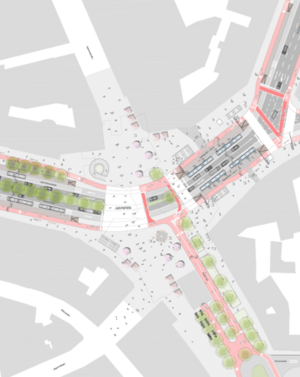The redesign of the Jahnplatz square (Bielefeld, Germany)

Area: urban
Date implemented: August 2018 (pilot); construction of the full project started June 2020
How long from concept to implementation: 1 year (pilot); 3-5 years (full project)
Relation between efforts undertaken and benefits achieved: good
What was done and how: Motorised individual traffic was reduced at a busy urban traffic node and the space was made more attractive for active travel and the public; this also reduced high NO2 concentrations. In the pilot phase, the following physical changes were implemented (costs less than EUR 10,000): bollards put in to separate the pedestrian/cycle street; traffic signs put up to advertise changes; a traffic island implemented to improve cycle connections. These changes were implemented during the summer school holidays to help people adapt while traffic was lower. Overall, transforming the square includes: lanes for general motorised traffic reduced from 2 to 1 in each direction; implementation of a bus lane and expansion/upgrade of cycling lane; transformation of an adjacent street into a pedestrian and cycling street; speed limit reduced from 50 to 30 km/h.
Why it worked to 'fast track' the innovation/measure: The pilot scheme was backed by a study, including simulations, to test the feasability before implementation. A pilot phase was used to help test and push the scheme forward despite its controversial nature. Public consultantions were held on the permanent scheme, which was also the focus of open political discussions, which raised interest. A low cost pilot showed measurable positive effects on emissions and traffic volumes.
Lessons learnt: Major changes to traffic nodes are a controversial choice. Use open dialogue to make people feel heard. Showcase clear motivation for the changes (e.g. excessive emission levels, unattractive urban space).
Tips for replication: Make the planning accessible by including the public; prove viability of measures through pilot schemes; push for evidence-based planning through use of studies and simulations.
Sources or links:
Date implemented: August 2018 (pilot); construction of the full project started June 2020
How long from concept to implementation: 1 year (pilot); 3-5 years (full project)
Relation between efforts undertaken and benefits achieved: good
What was done and how: Motorised individual traffic was reduced at a busy urban traffic node and the space was made more attractive for active travel and the public; this also reduced high NO2 concentrations. In the pilot phase, the following physical changes were implemented (costs less than EUR 10,000): bollards put in to separate the pedestrian/cycle street; traffic signs put up to advertise changes; a traffic island implemented to improve cycle connections. These changes were implemented during the summer school holidays to help people adapt while traffic was lower. Overall, transforming the square includes: lanes for general motorised traffic reduced from 2 to 1 in each direction; implementation of a bus lane and expansion/upgrade of cycling lane; transformation of an adjacent street into a pedestrian and cycling street; speed limit reduced from 50 to 30 km/h.
Why it worked to 'fast track' the innovation/measure: The pilot scheme was backed by a study, including simulations, to test the feasability before implementation. A pilot phase was used to help test and push the scheme forward despite its controversial nature. Public consultantions were held on the permanent scheme, which was also the focus of open political discussions, which raised interest. A low cost pilot showed measurable positive effects on emissions and traffic volumes.
Lessons learnt: Major changes to traffic nodes are a controversial choice. Use open dialogue to make people feel heard. Showcase clear motivation for the changes (e.g. excessive emission levels, unattractive urban space).
Tips for replication: Make the planning accessible by including the public; prove viability of measures through pilot schemes; push for evidence-based planning through use of studies and simulations.
Sources or links:






